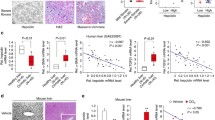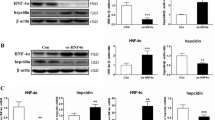Abstract
During the inflammatory process, hepcidin overexpression favours the development of anaemia of chronic diseases which represents the second most common form of anaemia worldwide. The identification of therapeutic agents decreasing hepcidin expression is therefore an important goal. The aim of this study was to target the STAT3 signalling involved in the development of increased hepcidin expression related to chronic inflammation. In a co-culture model associating mouse hepatocytes and rat liver epithelial cells, the mRNA levels of hepcidin1, albumin, aldolase B, Cyp3a4, Stat3, Smad4 and iron regulatory genes were measured by real-time PCR. STAT3 and phosphorylated SMAD1/5/8 proteins were analysed by Western blot. At variance of hepatocyte pure culture, co-culture provided high levels of hepcidin1 mRNA, reaching 400% of the freshly isolated hepatocyte values after 6 days of culture. Hepcidin expression was associated with the maintenance of hepatocyte phenotype, STAT3 phosphorylation and functional BMP/SMAD pathway. Stat3 siRNAs inhibited the hepcidin1 mRNA expression. STAT3 inhibitors, including curcumin, AG490 and a peptide (PpYLKTK), reduced hepcidin1 mRNA expression even when cells were additionally exposed to IL-6. Hepcidin1 mRNA was expressed at high levels by hepatocytes in the co-culture model, and STAT3 pathway activation was controlled through STAT3 inhibitors. Such inhibitors could be useful to prevent anaemia related to hepcidin overexpression during chronic inflammation.






Similar content being viewed by others
References
Krause A, Neitz S, Magert HJ, Schulz A, Forssmann WG, Schulz-Knappe P, Adermann K (2000) LEAP-1, a novel highly disulfide-bonded human peptide, exhibits antimicrobial activity. FEBS Lett 480:147–150
Pigeon C, Ilyin G, Courselaud B, Leroyer P, Turlin B, Brissot P, Loreal O (2001) A new mouse liver-specific gene, encoding a protein homologous to human antimicrobial peptide hepcidin, is overexpressed during iron overload. J Biol Chem 276:7811–7819
Nicolas G, Bennoun M, Devaux I, Beaumont C, Grandchamp B, Kahn A, Vaulont S (2001) Lack of hepcidin gene expression and severe tissue iron overload in upstream stimulatory factor 2 (USF2) knockout mice. Proc Natl Acad Sci USA 98:8780–8785
Nemeth E, Tuttle MS, Powelson J, Vaughn MB, Donovan A, Ward DM, Ganz T, Kaplan J (2004) Hepcidin regulates cellular iron efflux by binding to ferroportin and inducing its internalization. Science 306:2090–2093
Babitt JL, Huang FW, Wrighting DM, Xia Y, Sidis Y, Samad TA, Campagna JA, Chung RT, Schneyer AL, Woolf CJ, Andrews NC, Lin HY (2006) Bone morphogenetic protein signaling by hemojuvelin regulates hepcidin expression. Nat Genet 38:531–539
Pietrangelo A, Dierssen U, Valli L, Garuti C, Rump A, Corradini E, Ernst M, Klein C, Trautwein C (2007) STAT3 is required for IL-6-gp130-dependent activation of hepcidin in vivo. Gastroenterology 132:294–300
Verga Falzacappa MV, Vujic Spasic M, Kessler R, Stolte J, Hentze MW, Muckenthaler MU (2007) STAT3 mediates hepatic hepcidin expression and its inflammatory stimulation. Blood 109:353–358
Wrighting DM, Andrews NC (2006) Interleukin-6 induces hepcidin expression through STAT3. Blood 108:3204–3209
Wang RH, Li C, Xu X, Zheng Y, Xiao C, Zerfas P, Cooperman S, Eckhaus M, Rouault T, Mishra L, Deng CX (2005) A role of SMAD4 in iron metabolism through the positive regulation of hepcidin expression. Cell Metab 2:399–409
Verga Falzacappa MV, Casanovas G, Hentze MW, Muckenthaler MU (2008) A bone morphogenetic protein (BMP)-responsive element in the hepcidin promoter controls HFE2-mediated hepatic hepcidin expression and its response to IL-6 in cultured cells. J Mol Med 86:531–540
Truksa J, Lee P, Beutler E (2009) Two BMP responsive elements, STAT, and bZIP/HNF4/COUP motifs of the hepcidin promoter are critical for BMP, SMAD1, and HJV responsiveness. Blood 113:688–695
Casanovas G, Mleczko-Sanecka K, Altamura S, Hentze MW, Muckenthaler MU (2009) Bone morphogenetic protein (BMP)-responsive elements located in the proximal and distal hepcidin promoter are critical for its response to HJV/BMP/SMAD. J Mol Med 87:471–480
Nemeth E, Valore EV, Territo M, Schiller G, Lichtenstein A, Ganz T (2003) Hepcidin, a putative mediator of anemia of inflammation, is a type II acute-phase protein. Blood 101:2461–2463
Weiss G, Goodnough LT (2005) Anemia of chronic disease. N Engl J Med 352:1011–1023
Guguen-Guillouzo C, Guillouzo A (1983) Modulation of functional activities in cultured rat hepatocytes. Mol Cell Biochem 53–54:35–56
Courselaud B, Pigeon C, Inoue Y, Inoue J, Gonzalez FJ, Leroyer P, Gilot D, Boudjema K, Guguen-Guillouzo C, Brissot P, Loreal O, Ilyin G (2002) C/EBPalpha regulates hepatic transcription of hepcidin, an antimicrobial peptide and regulator of iron metabolism. Cross-talk between C/EBP pathway and iron metabolism. J Biol Chem 277:41163–41170
Clement B, Guguen-Guillouzo C, Campion JP, Glaise D, Bourel M, Guillouzo A (1984) Long-term co-cultures of adult human hepatocytes with rat liver epithelial cells: modulation of albumin secretion and accumulation of extracellular material. Hepatology 4:373–380
Fraslin JM, Kneip B, Vaulont S, Glaise D, Munnich A, Guguen-Guillouzo C (1985) Dependence of hepatocyte-specific gene expression on cell–cell interactions in primary culture. Embo J 4:2487–2491
Bharti AC, Donato N, Singh S, Aggarwal BB (2003) Curcumin (diferuloylmethane) down-regulates the constitutive activation of nuclear factor-kappa B and IkappaBalpha kinase in human multiple myeloma cells, leading to suppression of proliferation and induction of apoptosis. Blood 101:1053–1062
Catalano RD, Johnson MH, Campbell EA, Charnock-Jones DS, Smith SK, Sharkey AM (2005) Inhibition of Stat3 activation in the endometrium prevents implantation: a nonsteroidal approach to contraception. Proc Natl Acad Sci USA 102:8585–8590
Zhou Y, Zheng S, Lin J, Zhang QJ, Chen A (2007) The interruption of the PDGF and EGF signaling pathways by curcumin stimulates gene expression of PPARgamma in rat activated hepatic stellate cell in vitro. Lab Invest 87:488–498
Iwamaru A, Szymanski S, Iwado E, Aoki H, Yokoyama T, Fokt I, Hess K, Conrad C, Madden T, Sawaya R, Kondo S, Priebe W, Kondo Y (2007) A novel inhibitor of the STAT3 pathway induces apoptosis in malignant glioma cells both in vitro and in vivo. Oncogene 26:2435–2444
Troadec MB, Courselaud B, Detivaud L, Haziza-Pigeon C, Leroyer P, Brissot P, Loreal O (2006) Iron overload promotes cyclin D1 expression and alters cell cycle in mouse hepatocytes. J Hepatol 44:391–399
Gilot D, Serandour AL, Ilyin GP, Lagadic-Gossmann D, Loyer P, Corlu A, Coutant A, Baffet G, Peter ME, Fardel O, Guguen-Guillouzo C (2005) A role for caspase-8 and c-FLIPL in proliferation and cell-cycle progression of primary hepatocytes. Carcinogenesis 26:2086–2094
Fontaine J, Le Douarin NM (1977) Analysis of endoderm formation in the avian blastoderm by the use of quail-chick chimaeras. The problem of the neurectodermal origin of the cells of the APUD series. J Embryol Exp Morphol 41:209–222
Tateno C, Yoshizane Y, Saito N, Kataoka M, Utoh R, Yamasaki C, Tachibana A, Soeno Y, Asahina K, Hino H, Asahara T, Yokoi T, Furukawa T, Yoshizato K (2004) Near completely humanized liver in mice shows human-type metabolic responses to drugs. Am J Pathol 165:901–912
Pietrangelo A (2004) Hereditary hemochromatosis—a new look at an old disease. N Engl J Med 350:2383–2397
Lin L, Valore EV, Nemeth E, Goodnough JB, Gabayan V, Ganz T (2007) Iron transferrin regulates hepcidin synthesis in primary hepatocyte culture through hemojuvelin and BMP2/4. Blood 110:2182–2189
Ramey G, Deschemin JC, Vaulont S (2009) Cross-talk between the mitogen activated protein kinase and bone morphogenetic protein/hemojuvelin pathways is required for the induction of hepcidin by holotransferrin in primary mouse hepatocytes. Haematologica 94:765–772
Meydan N, Grunberger T, Dadi H, Shahar M, Arpaia E, Lapidot Z, Leeder JS, Freedman M, Cohen A, Gazit A, Levitzki A, Roifman CM (1996) Inhibition of acute lymphoblastic leukaemia by a Jak-2 inhibitor. Nature 379:645–648
Chung B, Matak P, McKie AT, Sharp P (2007) Leptin increases the expression of the iron regulatory hormone hepcidin in HuH7 human hepatoma cells. J Nutr 137:2366–2370
Turkson J, Ryan D, Kim JS, Zhang Y, Chen Z, Haura E, Laudano A, Sebti S, Hamilton AD, Jove R (2001) Phosphotyrosyl peptides block Stat3-mediated DNA binding activity, gene regulation, and cell transformation. J Biol Chem 276:45443–45455
Aggarwal BB, Shishodia S (2006) Molecular targets of dietary agents for prevention and therapy of cancer. Biochem Pharmacol 71:1397–1421
Jiao Y, Wilkinson J 4th, Christine Pietsch E, Buss JL, Wang W, Planalp R, Torti FM, Torti SV (2006) Iron chelation in the biological activity of curcumin. Free Radic Biol Med 40:1152–1160
Acknowledgements
This work was supported by grants from the EEC FP6 programme: LSHM-CT-2006-037296 Euroiron1, Région Bretagne (PRIR 139) and the “Association pour la Recherche contre le Cancer” (NF), Villejuif, France. We thank André Guillouzo and Christiane Guguen-Guillouzo for their critical reading of the manuscript and Catherine Ribault for her helpful technical contribution.
Disclosure of potential conflict of interests
The authors declare that they have no conflicting interests related to this study.
Author information
Authors and Affiliations
Corresponding author
Electronic supplementary material
Below is the link to the electronic supplementary material.
Rights and permissions
About this article
Cite this article
Fatih, N., Camberlein, E., Island, M.L. et al. Natural and synthetic STAT3 inhibitors reduce hepcidin expression in differentiated mouse hepatocytes expressing the active phosphorylated STAT3 form. J Mol Med 88, 477–486 (2010). https://doi.org/10.1007/s00109-009-0588-3
Received:
Revised:
Accepted:
Published:
Issue Date:
DOI: https://doi.org/10.1007/s00109-009-0588-3




